A Summary Analysis of Groundwater Vulnerability to Climate Variability and Anthropic Activities in the Haouz Region, Morocco
Abstract
1. Introduction
2. Study Area
3. Datasets and Methods
3.1. Rainfall and Temperature
3.2. Piezometric Level and Surface Water Flow
3.3. Evapotranspiration (ETP)
3.4. Normalized Difference Vegetation Index (NDVI) and Leaf Area Index (LAI)
4. Statistical Analyses
- The first step is to evaluate the ERA5 product, in order to check its utility for simulating the observed rainfall and temperature data in the study area.
- The second step is to provide a rationale for the choice of the time period selected for the analysis.
- The third step relates to the principal component analysis of the six selected piezometers, in order to identify those that show the same behavior.
- The fourth step consists in measuring the information between the time series related to each factor, and drawing their similarities according to the offset of one from the other, through cross-correlation. This method allows us to compare the different time series and determine the lag at which the series are best correlated. The correlation is maximum when the value of the correlation coefficient approaches +1 and −1. A positive correlation indicates that the values of the two factors tend to increase together, while a negative correlation means that the values of one variable tend to increase as the other decreases. The lead-lag effect means that an advanced series is correlated with another lagged series. Time series approaches have been widely used to assess aquifer recharge based on their simplicity and cost efficiency, as well as for their applicability to all types of terrains, climates and aquifers. The cross-correlation method has already been used in a drought-prone region in India to delineate the groundwater recharge zone in hard rock terrains, which was consistent with the result of GIS and remote sensing techniques [59]. It was also used in Korea to analyze the responses of the groundwater to the river stage fluctuations [60] to estimate the relationship between precipitation and water levels [61], and to analyze the influence of precipitation and river stage on groundwater levels [62]. In the Mediterranean, it was used in southern Italy to analyze the relation between karst spring discharge and rainfall [63], and in the Middle Atlas region of Morocco to assess the responses of karst springs to recharge [64].
- The fifth step consists of analyzing the temporal coevolution of the parameters of rainfall, runoff, vegetation development and piezometric level, in order to identify the presence or absence of a cascading effect between said factors. In fact, drought is one of the limiting factors that impact several aspects of the hydrological cycle [65]. Its propagation is usually felt in one hydrological process before reaching another [66]. In semi-arid regions, a drought episode that results in a precipitation deficit can lead to a reduction in vegetation cover, which in turn will lead to an increase in surface albedo for instance [67]. This was demonstrated by [68], illustrating the propagation of precipitation perturbations through different aspects of the hydrological cycle, leading to a cascading effect. This means that a precipitation deficit leads to a decrease in the runoff, soil moisture, stream flow and piezometric level. This method was applied in California to capture the cascading nature of the hydrological cycle and to make quantitative assessments of the evolution of each hydrological process [66].
5. Results
5.1. Evaluation of the ERA5 Product
5.2. Selection of the Analysis Period
5.3. Behavior Analysis of Different Datasets
5.3.1. Principal Component Analysis (PCA)
5.3.2. Cross-Correlation
5.3.3. Cascade Analysis
6. Discussion
7. Conclusions
Author Contributions
Funding
Institutional Review Board Statement
Informed Consent Statement
Data Availability Statement
Conflicts of Interest
References
- Yang, H.; Zehnder, A.J.B. Water Scarcity and Food Import: A Case Study for Southern Mediterranean Countries. World Dev. 2002, 30, 1413–1430. [Google Scholar] [CrossRef]
- Madulu, N.F. Linking Poverty Levels to Water Resource Use and Conflicts in Rural Tanzania. Phys. Chem. Earth Parts A/B/C 2003, 28, 911–917. [Google Scholar] [CrossRef]
- Lasserre, F. Conflits Hydrauliques et Guerres de l’eau: Un Essai de Modélisation. Rev. Int. Strat. 2007, 66, 105–118. [Google Scholar] [CrossRef]
- Tramblay, Y.; Hertig, E. Modelling Extreme Dry Spells in the Mediterranean Region in Connection with Atmospheric Circulation. Atmos. Res. 2018, 202, 40–48. [Google Scholar] [CrossRef]
- El Khalki, E.M.; Tramblay, Y.; Hanich, L.; Marchane, A.; Boudhar, A.; Hakkani, B. Climate Change Impacts on Surface Water Resources in the Oued El Abid Basin, Morocco. Hydrol. Sci. J. 2021, 66, 2132–2145. [Google Scholar] [CrossRef]
- Iglesias, A.; Garrote, L.; Flores, F.; Moneo, M. Challenges to Manage the Risk of Water Scarcity and Climate Change in the Mediterranean. Water Resour. Manag. 2007, 21, 775–788. [Google Scholar] [CrossRef]
- Sebbar, A.; Badri, W.; Fougrach, H.; Hsaine, M.; Saloui, A. Étude de La Variabilité Du Régime Pluviométrique Au Maroc Septentrional (1935–2004). Sci. Changements Planétaires/Sécheresse 2011, 22, 139–148. [Google Scholar]
- Stour, L.; Agoumi, A. Sécheresse climatique au Maroc durant les dernières décennies. Hydroécol. Appl. 2008, 16, 215–232. [Google Scholar] [CrossRef]
- Bijaber, N.; Rochdi, A. Télédétection Spatiale Pour l’évaluation Du Risque de Sécheresse Au Maroc. Rev. Int. Géomatique 2017, 27, 203–221. [Google Scholar] [CrossRef]
- Strohmeier, S.; López López, P.; Haddad, M.; Nangia, V.; Karrou, M.; Montanaro, G.; Boudhar, A.; Linés, C.; Veldkamp, T.; Sterk, G. Surface Runoff and Drought Assessment Using Global Water Resources Datasets-from Oum Er Rbia Basin to the Moroccan Country Scale. Water Resour Manag. 2020, 34, 2117–2133. [Google Scholar] [CrossRef]
- Hadri, A.; Saidi, M.E.; Boudhar, A. Multiscale Drought Monitoring and Comparison Using Remote Sensing in a Mediterranean Arid Region: A Case Study from West-Central Morocco. Arab. J. Geosci. 2021, 14, 118. [Google Scholar] [CrossRef]
- Ait-Brahim, Y.; Saidi, M.E.; Khaoula, K.; Sifeddine, A.; Bouchaou, L. Analysis of Observed Climate Trends and High Resolution Scenarios for the 21st Century in Morocco. J. Mater. Environ. Sci. 2017, 8, 1375–1384. [Google Scholar]
- Nouaceur, Z.; Murărescu, O.; Muratoreanu, G. Climatic Changes in the Maghreb Region: The Evolution of the Pluviometric Parameters in the Middle Atlas and at Its Margins (Morocco) and Its Relation to the North Atlantic Oscillation. Air Water Pollut. 2013, 2013, 285–292. [Google Scholar]
- Ouhamdouch, S.; Bahir, M.; Ouazar, D.; Carreira, P.; Zouari, K. Evaluation of Climate Change Impact on Groundwater from Semi-Arid Environment (Essaouira Basin, Morocco) Using Integrated Approaches. Environ. Earth Sci. 2019, 78, 449. [Google Scholar] [CrossRef]
- Sinan, M.; Belhouji, A. Impact du changement climatique sur le climat et les ressources en eau du Maroc aux horizons 2020, 2050 et 2080 et mesures d’adaptation. La Houille Blanche 2016, 4, 32–39. [Google Scholar] [CrossRef]
- Tuel, A.; Kang, S.; Eltahir, E.A. Understanding Climate Change over the Southwestern Mediterranean Using High-Resolution Simulations. Clim. Dyn. 2021, 56, 985–1001. [Google Scholar] [CrossRef]
- Abtew, W.; Melesse, A. Evaporation and Evapotranspiration: Measurements and Estimations; Springer Science & Business Media: Berlin/Heidelberg, Germany, 2012; ISBN 978-94-007-4737-1. [Google Scholar]
- Hssaisoune, M.; Bouchaou, L.; Sifeddine, A.; Bouimetarhan, I.; Chehbouni, A. Moroccan Groundwater Resources and Evolution with Global Climate Changes. Geosciences 2020, 10, 81. [Google Scholar] [CrossRef]
- Abourida, A.; Simonneaux, V.; Errouane, S.; Sighir, F.; Berjami, B.; Sgir, F. Estimation Des Volumes d’eau Pompés Dans La Nappe Pour l’irrigation (Plaine Du Haouz, Marrakech, Maroc). Comparaison d’une Méthode Statistique et d’une Méthode Basée Sur l’utilisation de Données de Télédétection. J. Water Sci./Rev. Des Sci. De L’eau 2008, 21, 489–501. [Google Scholar]
- Fniguire, F.; Laftouhi, N.-E.; Saidi, M.E.; Markhi, A. Some Aspects of Climate Variability and Increasing Aridity in Central Morocco over the Last Forty Years: Case of Tensift Basin (Marrakech-Morocco). J. Environ. Earth Sci. 2014, 4, 42–51. [Google Scholar]
- Bennani, O.; Ait-Brahim, Y.; Saidi, M.E.; Fatima, F. Variability of Surface Water Resources and Extreme Flows under Climate Change Conditions in Arid and Mediterranean Area: Case of Tensift Watershed, Morocco. J. Biodivers. Environ. Sci. 2016, 9, 165–174. [Google Scholar]
- Aitelmekki, O.; Laftouhi, N.-E.; Hanich, L. Estimate of Regional Groundwater Recharge Rate in the Central Haouz Plain, Morocco, Using the Chloride Mass Balance Method and a Geographical Information System. Appl. Water Sci. 2015, 7, 1679–1688. [Google Scholar] [CrossRef][Green Version]
- Belaqziz, S.; Khabba, S.; Er-Raki, S.; Jarlan, L.; Le Page, M.; Kharrou, M.H.; Adnani, M.E.; Chehbouni, A. A New Irrigation Priority Index Based on Remote Sensing Data for Assessing the Networks Irrigation Scheduling. Agric. Water Manag. 2013, 119, 1–9. [Google Scholar] [CrossRef]
- Ahmed, M.; Aqnouy, M.; Stitou El Messari, J. Sustainability of Morocco’s Groundwater Resources in Response to Natural and Anthropogenic Forces. J. Hydrol. 2021, 603, 126866. [Google Scholar] [CrossRef]
- Abourida, A. Approche Hydrogéologique de La Nappe du HAOUZ (Maroc) Par Télédétection, Isotopie, SIG et Modélisation; Faculté des Sciences Semlalia, Université Cadi Ayyad: Marrakech, Morocco, 2007. [Google Scholar]
- Mishra, A.K.; Singh, V.P. A Review of Drought Concepts. J. Hydrol. 2010, 391, 202–216. [Google Scholar] [CrossRef]
- Ruf, T.; Kleiche-Dray, M. Les Eaux d’irrigation Du Haouz de Marrakech: Un Siècle de Confrontations Des Modèles de Gestion Publics, Privés et Communautaires. EchoGéo 2018, 43, 42. [Google Scholar] [CrossRef]
- Tanouti, O.; Molle, F. Réappropriations de l’eau Dans Les Bassins Versants Surexploités. Le Cas Du Bassin Du Tensift (Maroc). Études Rural. 2013, 192, 79–96. [Google Scholar] [CrossRef]
- Zkhiri, W.; Tramblay, Y.; Hanich, L.; Jarlan, L.; Ruelland, D. Spatiotemporal Characterization of Current and Future Droughts in the High Atlas Basins (Morocco). Theor. Appl. Climatol. 2019, 135, 593–605. [Google Scholar] [CrossRef]
- Meliho, M.; Khattabi, A.; Jobbins, G.; Sghir, F. Impact of Meteorological Drought on Agriculture in the Tensift Watershed of Morocco. J. Water Clim. Chang. 2019, 11, 1323–1338. [Google Scholar] [CrossRef]
- Habitou, N.; Morabbi, A.; Ouazar, D.; Bouziane, A.; Hasnaoui, M.D.; Sabri, H. CHIRPS Precipitation Open Data for Drought Monitoring: Application to the Tensift Basin, Morocco. J. Appl. Remote Sens. 2020, 14, 034526. [Google Scholar]
- Analy, M.; Laftouhi, N.-E. Groundwater Depletion in an Urban Environment under Semiarid Climate and Persistent Drought–City of Marrakesh (Morocco). Water 2021, 13, 3253. [Google Scholar] [CrossRef]
- Cotti, D.; Harb, M.; Hadri, A.; Aboufirass, M.; Chaham, K.R.; Libertino, A.; Campo, L.; Trasforini, E.; Krätzschmar, E.; Bellert, F.; et al. An Integrated Multi-Risk Assessment for Floods and Drought in the Marrakech-Safi Region (Morocco). Front. Water 2022, 4, 75. [Google Scholar] [CrossRef]
- Houmma, I.; Mansouri, L.; Gadal, S.; Mansour Badamassi, M.B.; Hadria, R. Prospective Analysis of Spatial Heterogeneity Influence on the Concordance of Remote Sensing Drought Indices: A Case of Semi-Arid Agrosystems in Morocco (Moulouya and Tensift Watersheds). Geocarto Int. 2022, 37, 1–21. [Google Scholar] [CrossRef]
- Houmma, I.; Mansouri, L.; Hadria, R.; Anas, E.; Chehbouni, A. Retrospective Analysis and Version Improvement of the Satellite-Based Drought Composite Index. A Semi-Arid Tensift-Morocco Application. Geocarto Int. 2020, 37, 1–22. [Google Scholar] [CrossRef]
- Moukhchane, M. Contribution à L’étude des Réservoirs Aquifères Profonds de la Bordure Nord de l’Atlas Entre Demnat et Imin’Tanout (Maroc). Ph.D. Thesis, Université de Franche-Comté, Besançon, France, 1983. [Google Scholar]
- Sinan, M. Méthodologie d’identification, d’évaluation et de Protection Des Ressources En Eau Des Aquifères Régionaux Par La Combinaison Des SIG, de La Géophysique et de La Géostatistique: Application à l’aquifère Du Haouz de Marrakech (Maroc). Ph.D. Thesis, Université Mohammed V, Ecole Mohammedia des Ingénieurs, Rabat, Morocco, 2000. [Google Scholar]
- Rmiki, A.; El Achheb, A.; Ennih, N. Hydrogeological and Geochemical Approach in the Study of Groundwater Salinity of Central Haouz. Eur. J. Sci. Res. 2021, 154, 328–344. [Google Scholar]
- Aitelmekki, O.; Laftouhi, N.-E. Combination of a Geographical Information System and Remote Sensing Data to Map Groundwater Recharge Potential in Arid to Semi-Arid Areas: The Haouz Plain, Morocco. Earth Sci. Inform. 2016, 9, 465–479. [Google Scholar] [CrossRef]
- Ghazali, F.E.E.; Laftouhi, N.-E.; Fekri, A.; Randazzo, G.; Benkirane, M. Enhancing the Success of New Dams Implantation under Semi-Arid Climate, Based on a Multicriteria Analysis Approach: Case of Marrakech Region (Central Morocco). Open Geosci. 2021, 13, 1494–1508. [Google Scholar] [CrossRef]
- Er-Raki, S.; Chehbouni, A.; Khabba, S.; Simonneaux, V.; Jarlan, L.; Ouldbba, A.; Rodriguez, J.C.; Allen, R. Assessment of Reference Evapotranspiration Methods in Semi-Arid Regions: Can Weather Forecast Data Be Used as Alternate of Ground Meteorological Parameters? J. Arid. Environ. 2010, 74, 1587–1596. [Google Scholar] [CrossRef]
- Montginoul, M.; Molle, F. Modernisation Des Périmètres Irrigués Au Maroc: Une Solution Aux Effets Contrastés Pour Les Agriculteurs et La Ressource En Eau. Le Cas d’un Périmètre Du N’Fis-Haouz; Irstea; IRD-Institut de Recherche Pour le Developpement; UMR G-Eau: Montpellier, France, 2019; p. 47. [Google Scholar]
- Ge, J.; Jun, F.; Yuan, H.; Yang, X.; Jin, M.; Wang, S. Soil Water Depletion and Restoration under Inter-Conversion of Food Crop and Alfalfa with Three Consecutive Wet Years. J. Hydrol. 2020, 585, 124851. [Google Scholar] [CrossRef]
- Acharya, B.; Sandhu, D.; Ferreira, J.F.S. Physiological, Morphological, Biochemical, and Genetic Responses of Alfalfa to Salinity; Springer: Cham, Switzerland, 2021; pp. 145–157. ISBN 978-3-030-74465-6. [Google Scholar]
- Salih, W.; Chehbouni, A.; Epule, T.E. Evaluation of the Performance of Multi-Source Satellite Products in Simulating Observed Precipitation over the Tensift Basin in Morocco. Remote Sens. 2022, 14, 1171. [Google Scholar] [CrossRef]
- Abdullahi, J.; Elkiran, G. Prediction of the Future Impact of Climate Change on Reference Evapotranspiration in Cyprus Using Artificial Neural Network. Procedia Comput. Sci. 2017, 120, 276–283. [Google Scholar] [CrossRef]
- Papadavid, G.; Diofantos, H. Integrated Approach of Remote Sensing and Micro-Sensor Technology for Estimating Evapotranspiration in Cyprus. Agric. Eng. Int. CIGR J. 2010, 12, 1–11. [Google Scholar]
- Mjejra, M.; Dubreuil, V.; Hénia, L. Suivi de la Sécheresse Agro-Climatique à Partir du Déficit D’évaporation Dans le Bassin Versant de Mejerda (Tunisie). In Proceedings of the XXVIIIe Colloque de l’Association Internationale de Climatologie; 2015; p. 369. Available online: http://climatologie.be/aic/colloques/actes/ACTES_AIC2015/5%20Variabilites%20et%20aleas%20climatiques/070-CARMELLO-439-444.pdf (accessed on 29 August 2022).
- Tanner, C.; Jury, W. Estimating Evaporation and Transpiration from a Row Crop during Incomplete Cover 1. Agron. J. 1976, 68, 239–243. [Google Scholar] [CrossRef]
- HAMIMED, A.; Menaa, R.; Benslimane, M.; Bouabdellah, L. Cartographie de l’évapotranspiration Réelle Journalière Dans Les Conditions Semi-Arides En Algérie à Partir Des Données Satellitaires Aster. Sci. Changements Planetaires-Secher. 2008, 19, 293–300. [Google Scholar] [CrossRef]
- Gao, Y.; Zhao, C.; Ashiq, M.W.; Wang, Q.; Rong, Z.; Liu, J.; Mao, Y.; Zhaoxia, G.; Wang, W. Actual Evapotranspiration of Subalpine Meadows in the Qilian Mountains, Northwest China. J. Arid. Land 2019, 11, 371–384. [Google Scholar] [CrossRef]
- Running, S.W.; Mu, Q.; Zhao, M.; Moreno, A. MODIS Global Terrestrial Evapotranspiration (ET) Product (NASA MOD16A2/A3) NASA Earth Observing System MODIS Land Algorithm; NASA: Washington, DC, USA, 2017.
- Mu, Q.; Zhao, M.; Running, S. MODIS Global Terrestrial Evapotranspiration (ET) Product (NASA MOD16A2/A3) Collection 5. NASA Headquarters; Numerical Terradynamic Simulation Group Publications: Macau, China, 2013. [Google Scholar]
- Costa, L.; Nunes, L.; Ampatzidis, Y. A New Visible Band Index (VNDVI) for Estimating NDVI Values on RGB Images Utilizing Genetic Algorithms. Comput. Electron. Agric. 2020, 172, 105334. [Google Scholar] [CrossRef]
- Escadafal, R.; Huete, A. Etude Des Propriétés Spectrales Des Sols Arides Appliquée à l’amélioration Des Indices de Végétation Obtenus Par Télédétection. Comptes Rendus De L’académie Des Sci. Sér. 2 Méc. Phys. Chim. Sci. De L’univers Sci. De La Terre 1991, 312, 1385–1391. [Google Scholar]
- Solly, B.; Oumar, S.; Jarju, A.M.; Tidiane, S. Détection Des Zones de Dégradation et de Régénération de La Couverture Végétale Dans Le Sud Du Sénégal à Travers l’analyse Des Tendances de Séries Temporelles MODIS NDVI et Des Changements d’occupation Des Sols à Partir d’images LANDSAT. Rev. Fr. Photogramm. Télédétect. 2021, 223, 1–15. [Google Scholar] [CrossRef]
- Liang, L.; Huang, T.; Di, L.; Geng, D.; Yan, J.; Wang, S.; Wang, L.; Li, L.; Chen, B.; Kang, J. Influence of Different Bandwidths on LAI Estimation Using Vegetation Indices. IEEE J. Sel. Top. Appl. Earth Obs. Remote Sens. 2020, 13, 1494–1502. [Google Scholar] [CrossRef]
- Shinzato, P.; Duarte, D. Microclimatic Effect of Vegetation for Different Leaf Area Index-LAI. In Proceedings of the 28th Conference, Opportunities, Limits & Needs towards an Environmentally Responsible Architecture, Lima, Peru, 7–9 November 2012. [Google Scholar]
- Mondal, N.; Singh, V. A New Approach to Delineate the Groundwater Recharge Zone in Hard Rock Terrain. Curr. Sci. 2004, 87, 658–662. [Google Scholar]
- Ha, K.; Ko, K.-S.; Koh, D.-C.; Yum, B.-W.; Lee, G. Time Series Analysis of the Responses of the Groundwater Levels at Multi-Depth Wells According to the River Stage Fluctuations. Econ. Environ. Geol. 2006, 39, 269–284. [Google Scholar]
- Lee, J.M.; Park, J.H.; Chung, E.; Woo, N.C. Assessment of Groundwater Drought in the Mangyeong River Basin, Korea. Sustainability 2018, 10, 831. [Google Scholar] [CrossRef]
- Kim, I.; Park, D.; Kyung, D.; Kim, G.; Kim, S.; Lee, J. Comparative Influences of Precipitation and River Stage on Groundwater Levels in Near-River Areas. Sustainability 2016, 8, 1. [Google Scholar] [CrossRef]
- Fiorillo, F.; Doglioni, A. The Relation between Karst Spring Discharge and Rainfall by the Cross-Correlation Analysis. Hydrogeol. J. 2010, 18, 1881–1895. [Google Scholar] [CrossRef]
- Howell, B.; Fryar, A.; Benaabidate, L.; Bouchaou, L.; Farhaoui, M. Variable Responses of Karst Springs to Recharge in the Middle Atlas Region of Morocco. Hydrogeol. J. 2019, 27, 1693–1710. [Google Scholar] [CrossRef]
- Pointet, T. To Be Resilient to Drought. La Houille Blanche 2020, 106, 45–50. [Google Scholar] [CrossRef]
- Massoud, E.; Turmon, M.; Reager, J.; Hobbs, J.; Liu, Z.; David, C.H. Cascading Dynamics of the Hydrologic Cycle in California Explored through Observations and Model Simulations. Geosciences 2020, 10, 71. [Google Scholar] [CrossRef]
- Entekhabi, D.; Rodriguez-Iturbe, I.; Bras, R.L. Variability in Large-Scale Water Balance with Land Surface-Atmosphere Interaction. J. Clim. 1992, 5, 798–813. [Google Scholar] [CrossRef]
- Changnon, S.A. Detecting Drought Conditions in Illinois. Circ. No. 169. 1987. Available online: https://www.isws.illinois.edu/pubdoc/C/ISWSC-169.pdf (accessed on 29 August 2022).
- Triki, I.; Trabelsi, N.; Hentati, I.; Zairi, M. Groundwater Levels Time Series Sensitivity to Pluviometry and Air Temperature: A Geostatistical Approach to Sfax Region, Tunisia. Environ. Monit. Assess. 2014, 186, 1593–1608. [Google Scholar] [CrossRef]
- Hajhouji, Y. Modélisation Hydrologique Du Bassin Versant de l’oued Rheraya et Sa Contribution à La Recharge de La Nappe Du Haouz (Bassin Du Tensift, Maroc); Université Paul Sabatier-Toulouse III: Toulouse, France, 2018. [Google Scholar]

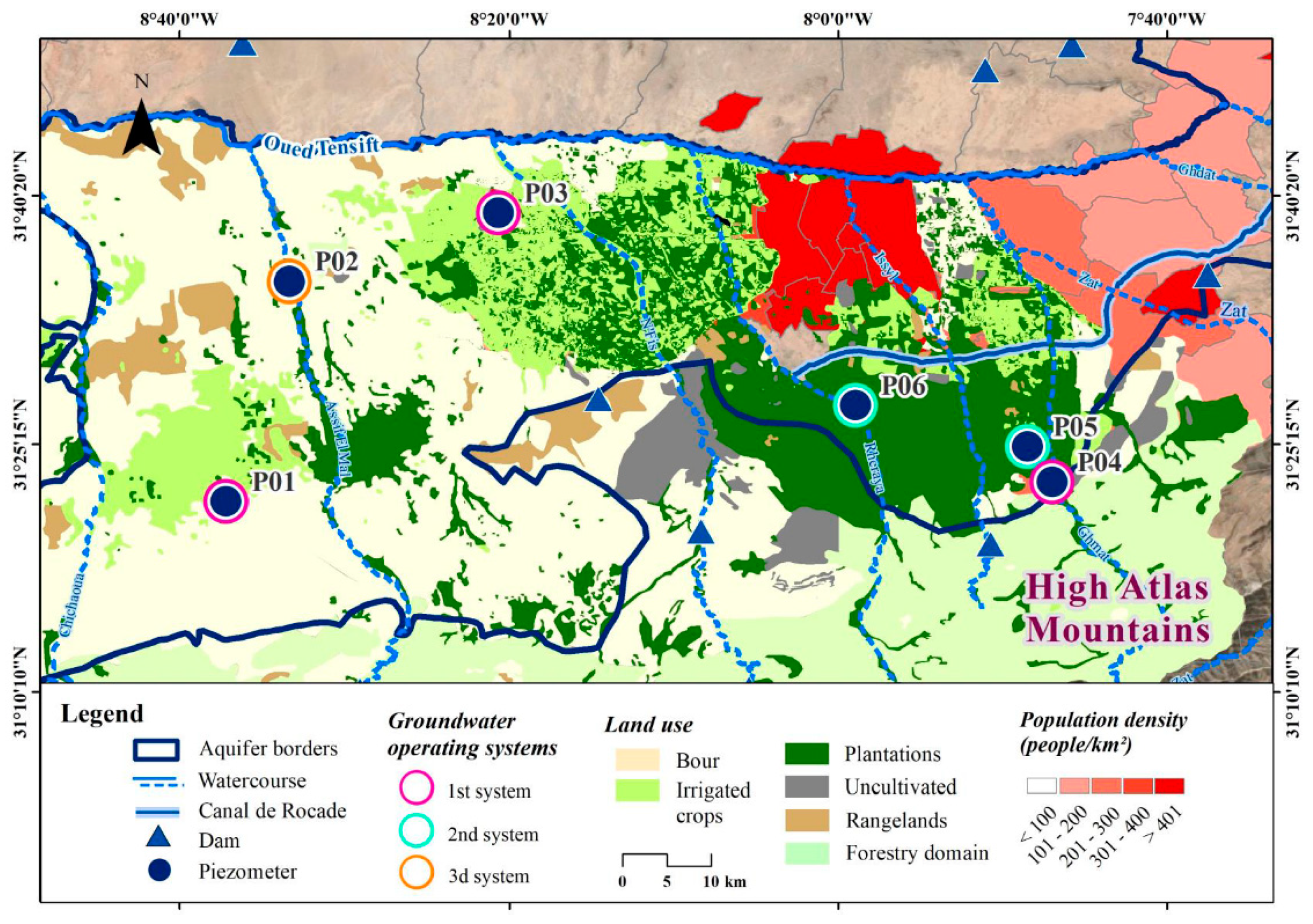
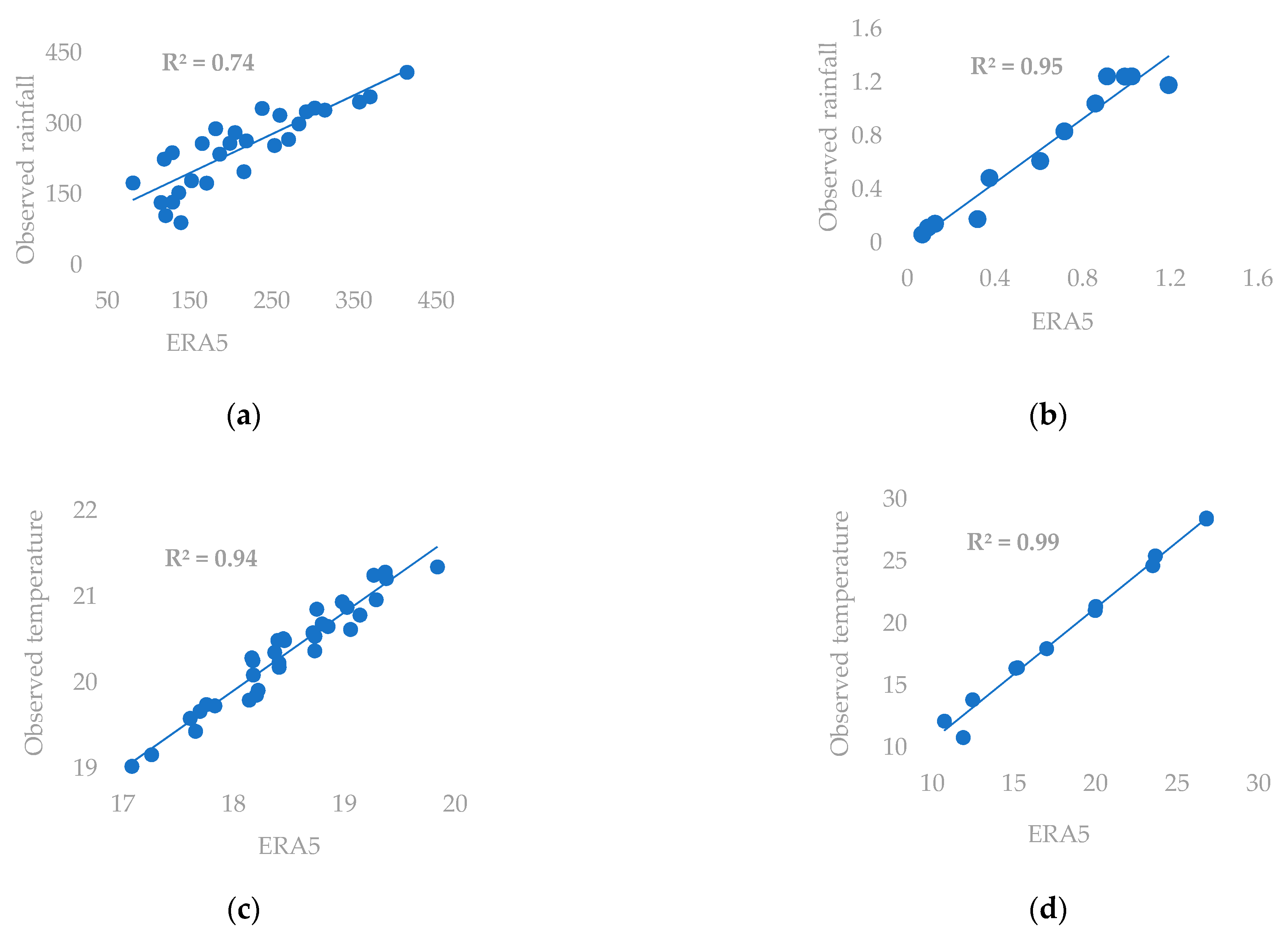
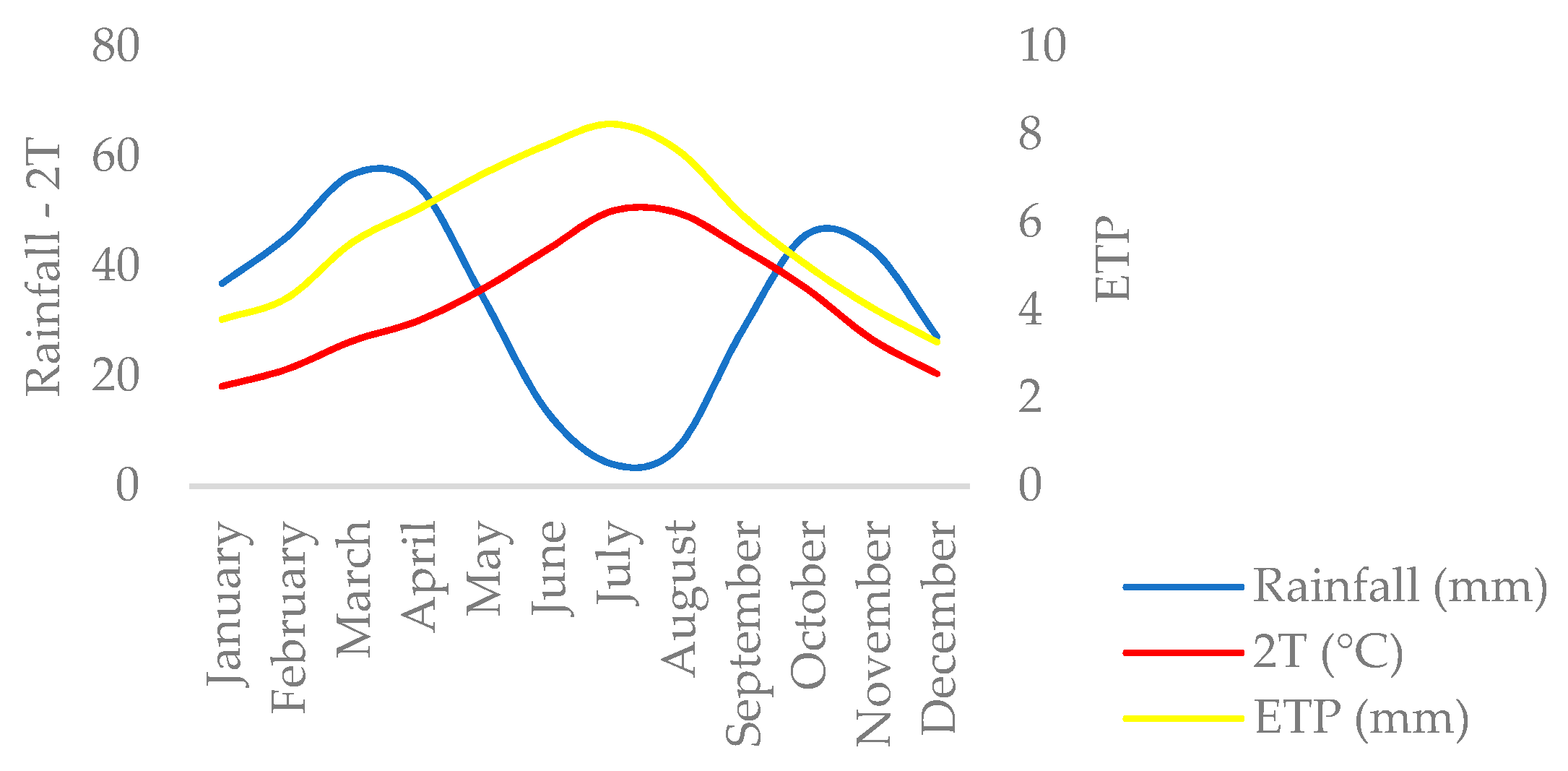
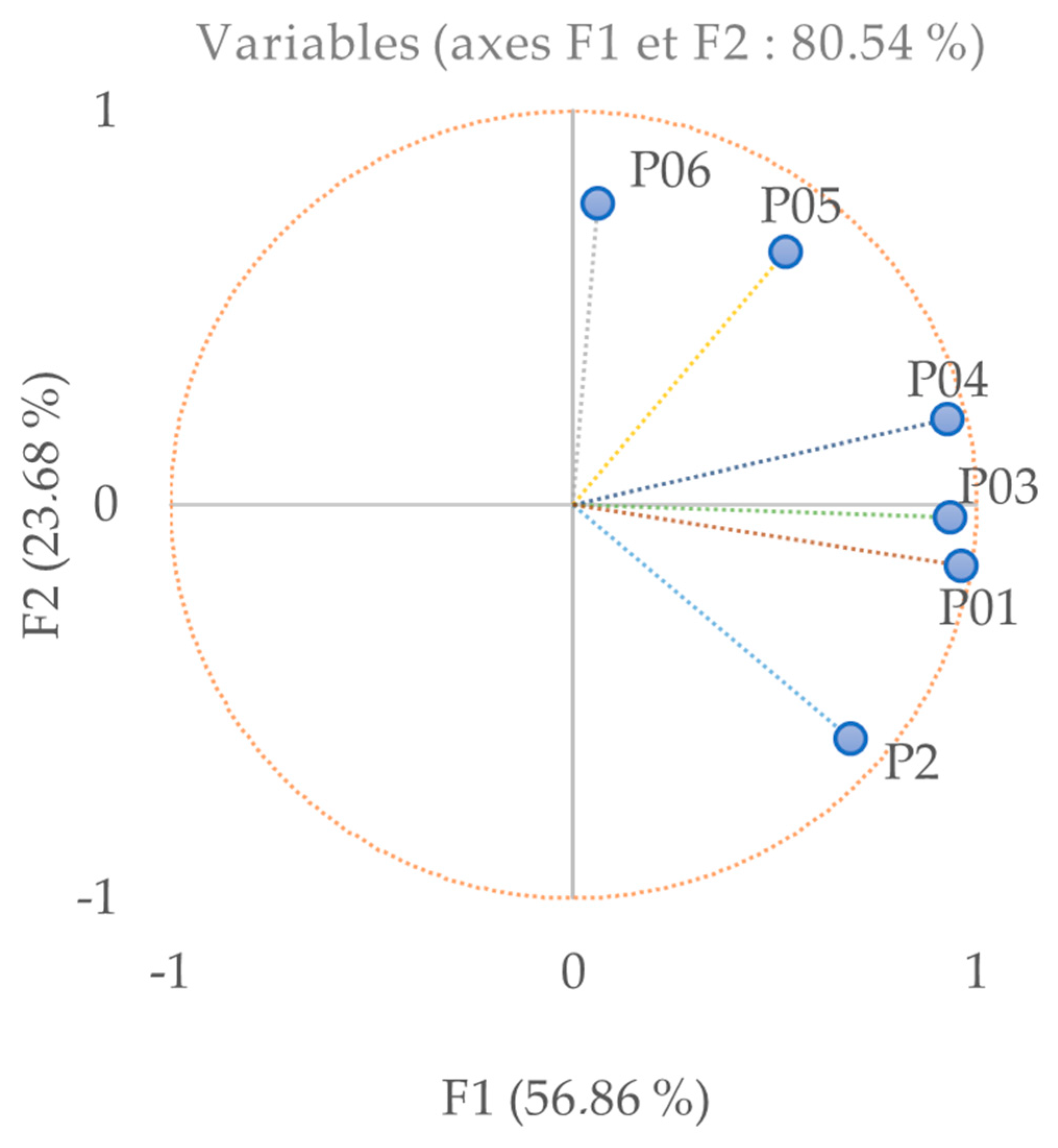
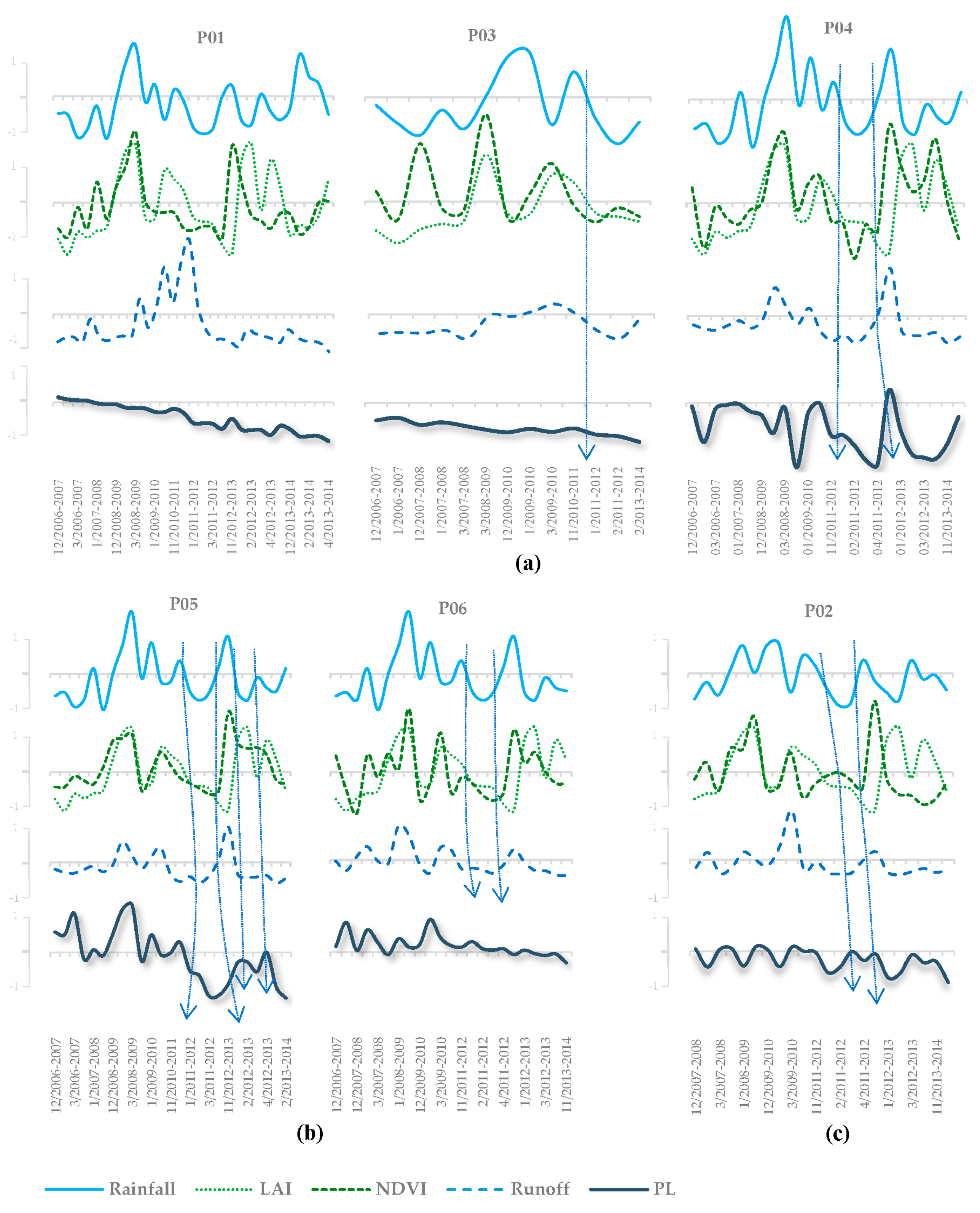
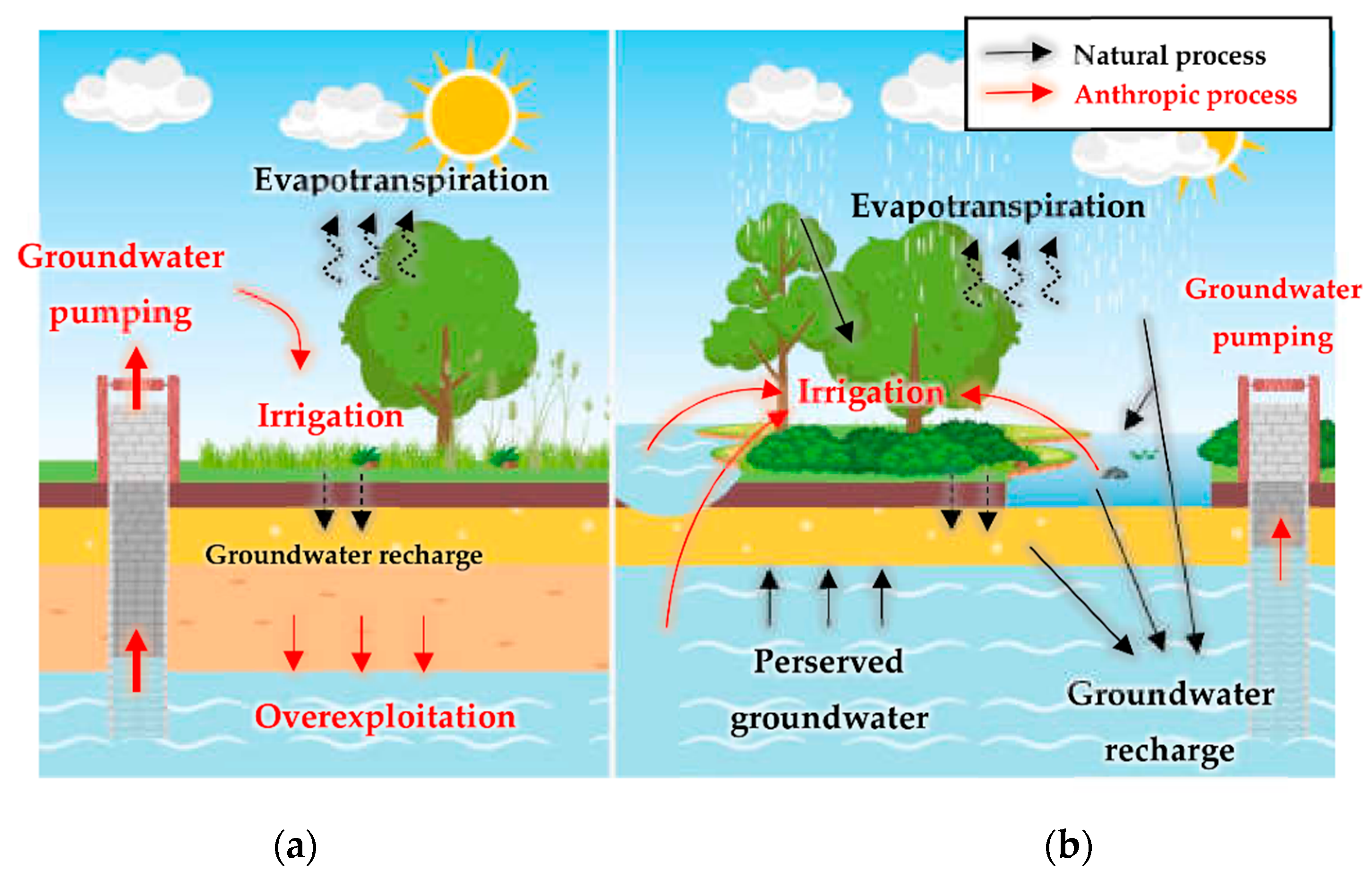
| Id | Piezometer | X | Y | Periods of Records | Time Step |
|---|---|---|---|---|---|
| P01 | 1133/52 | −8.620027 | 31.363085 | 1998–2020 | Monthly data |
| P02 | 3590/53 | −8.556463 | 31.585687 | 1998–2020 | Monthly data |
| P03 | 4442/45 | −8.344447 | 31.655031 | 1998–2020 | Monthly data |
| P04 | 766/53 | −7.78323 | 31.382611 | 1986–2020 | Monthly data |
| P05 | 2701/53 | −7.807982 | 31.418541 | 1979–2020 | Monthly data |
| P06 | 2700/53 | −7.982378 | 31.460688 | 1984–2020 | Monthly data |
| First System | Second System | Third System | ||||
|---|---|---|---|---|---|---|
| P01 (Irrigated Cultures) | P03 (Irrigated Cultures) | P04 (Plantations) | P05 (Plantations) | P06 (Plantations) | P02 (Bour) | |
| Rainfall (leads, negative lags) | 0.40 (lag = −4) | 1.00 (lag = −3) | 0.65 (lag = 0) | |||
| Local NDVI (leads, positive lags) | −0.67 (lag = −4) | −0.79 (lag = −5) | 0.98 (lag = −4) | 0.40 (lag = 0) | 1.00 (lag = 0) | |
| Average LAI (leads, positive lags) | −0.86 (lag = −2) | −0.96 (lag = −3) | −0.88 (lag = −1) | 0.90 (lag = 0) | 1.00 (lag = 0) | 0.50 (lag = 0) |
| Runoff (leads, positive lags) | 0.40 (lag = 1) | 0.40 (lag = −4) | 0.82 (lag = 2) | 0.92 (lag = 0) | ||
Publisher’s Note: MDPI stays neutral with regard to jurisdictional claims in published maps and institutional affiliations. |
© 2022 by the authors. Licensee MDPI, Basel, Switzerland. This article is an open access article distributed under the terms and conditions of the Creative Commons Attribution (CC BY) license (https://creativecommons.org/licenses/by/4.0/).
Share and Cite
El Bouazzaoui, I.; Ait Brahim, Y.; El Khalki, E.M.; Najmi, A.; Bougadir, B. A Summary Analysis of Groundwater Vulnerability to Climate Variability and Anthropic Activities in the Haouz Region, Morocco. Sustainability 2022, 14, 14865. https://doi.org/10.3390/su142214865
El Bouazzaoui I, Ait Brahim Y, El Khalki EM, Najmi A, Bougadir B. A Summary Analysis of Groundwater Vulnerability to Climate Variability and Anthropic Activities in the Haouz Region, Morocco. Sustainability. 2022; 14(22):14865. https://doi.org/10.3390/su142214865
Chicago/Turabian StyleEl Bouazzaoui, Imane, Yassine Ait Brahim, El Mahdi El Khalki, Adam Najmi, and Blaid Bougadir. 2022. "A Summary Analysis of Groundwater Vulnerability to Climate Variability and Anthropic Activities in the Haouz Region, Morocco" Sustainability 14, no. 22: 14865. https://doi.org/10.3390/su142214865
APA StyleEl Bouazzaoui, I., Ait Brahim, Y., El Khalki, E. M., Najmi, A., & Bougadir, B. (2022). A Summary Analysis of Groundwater Vulnerability to Climate Variability and Anthropic Activities in the Haouz Region, Morocco. Sustainability, 14(22), 14865. https://doi.org/10.3390/su142214865









